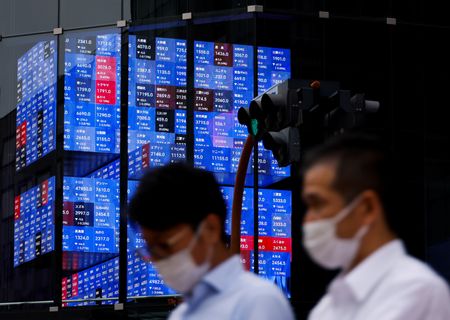
By Wayne Cole
SYDNEY (Reuters) – Asian stocks looked set for a choppy start on Monday after Beijing denied it was considering easing its zero COVID-19 policy, helping the dollar recover some losses while dealing a setback to commodities.
Risk assets had rallied on Friday amid speculation China was preparing to relax its pandemic restrictions, but over the weekend health officials reiterated their commitment to the “dynamic-clearing” approach to COVID cases as soon as they emerge.
“Despite the denial, notions that China will pivot to living with COVID in the new year are unlikely to be quashed given the very real toll that zero-COVID is having on the economy,” said Tapas Strickland, head of market economics at NAB.
“With China going into winter, most analysts think a change in zero-COVID is unlikely until at least March.”
Speculation that China might open its economy saw copper jump 7% on Friday in its biggest one-day rally since 2009, while a range of resources all benefited from hopes of increased demand. [MET/L]
It also sent the yuan surging and triggered a round of profit taking on long U.S. dollar positions, particularly against commodity sensitive currencies such as the Australian dollar.
Some of that reversed early Monday, with the Aussie down 0.8% at $0.6414 after jumping 3% on Friday. The U.S. dollar index bounced 0.6% having dived almost 2% at the end of last week. [FRX/]
The dollar edged back up to 147.23 yen, while the euro eased 0.6% to $0.9899.
Aiding risk sentiment at the margin were reports the White House is privately encouraging Ukraine to signal an openness to negotiate with Russia.
Dealers were still digesting a mixed U.S jobs report which showed solid gains in the payrolls survey but softness in the less reliable household survey of unemployment.
Four Federal Reserve policymakers on Friday indicated they would still consider a smaller interest rate hike at their next policy meeting, sounding less hawkish than Chair Jerome Powell.
There are at least seven Fed officials scheduled to speak this week, which will help refine the rate outlook with markets now narrowly leaning toward a half-point rate hike next month to 4.25-4.5%.
“We maintain the Fed will see sufficient progress on inflation to pause at 4.75% in February, but the risks are skewed to more hikes that likely bring about a recession sometime later in 2023 or early 2024,” said Bruce Kasman, head of economic research at JPMorgan.
Short-term Treasuries managed a minor rally on Friday with two-year yields edging back to 4.66% and off highs not seen since 2007.
The market faces a major hurdle on Thursday when U.S. consumer prices for October are released, with any upside surprise set to test hopes for a step down in Fed hikes.
Median forecasts are for annual CPI inflation to slow to 8.0% and for the core to dip a tick to 6.5%.
Also of note will be midterm U.S. elections on Tuesday where Republicans could win control of one or both chambers and lead to deadlock on fiscal policy.
In commodity markets, gold was holding firm for now at $1,680 an ounce after jumping 3% on Friday. [GOL/]
Oil futures were yet to trade having climbed around 5% late last week on the China talk. [O/R]
(Editing by Daniel Wallis)

